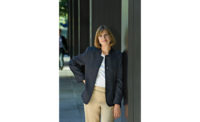Ah, Nature. As much as we architects love the natural world and find it a constant source of revelation, we prefer to view it from a human-made perch or platform. Call it a professional bias toward the constructed landscape. When rambling through the unfettered woodland depths, our feet inevitably find the pathways, the Appalachian trails of the world, where we stop to surmise: How could this walkway be improved? Pathetic? Comedic? Ironic? We cannot escape our fate, so inescapable is the design impulse.

In New York, the admixture of human will and nature collides with power along the Hudson, where Manhattan’s sky-blown canvas stretches as broadly as any painting by J.M.W. Turner. Seated on a bench near the tip of the Battery, the eye sweeps 180-degrees, up north toward the Palisades, past the intermittent islands (Ellis, Governor’s), and down to the Narrows. Cloud forms like lightly spun lanterns catch the morning light; in the evening, the sunsets blaze, then burn into New Jersey’s heart, while the constant vector of the Hudson pushes down and out. The coda and changeable opening chorus of the Empire state.
A light-catcher, most apparent from a park bench directly across from the Battery, the Goldman Sachs tower, by Cesar Pelli (2001–04), anchors the harbor, where it sets a heroic, multifaceted spike into the landscape. Such a physical setting of operatic scale deserves a building with both magnitude and gravitas, which Pelli’s 42-story tower delivers, stepping from a massive base in a carefully controlled, syncopated thrust, up and up again. Who today understands the tall building, the reticulated tall building, better than he?
Downstream, we catch the historic arm and torch of liberty’s personification, our Lady of the Harbor, a diminutive, verdigris figure, but a resolute one, constantly overseeing the sweep of sailboats and ferries plunging and plowing their way around the harbor. Beyond our range, around Manhattan’s tip, Olafur Eliasson’s waterfall plunges into the East River as if into a Hudson River cataract, while at the edge of sight, the twin arches of the Verrazano bridge link Brooklyn and Staten Island in a complete Romantic vista.
Though the view above the horizon seems untamed, even the vantage point has unnatural roots. The land that holds the Museum of Jewish Heritage (Kevin Roche John Dinkeloo and Associates, 2001), Wagner Park (Machado Silvetti, architects; Olin Partnership, landscape architect; Lynden Miller, garden design, 1996), and Battery Park City itself rests on 92 acres of landfill. The 1.2-mile-long esplanade, a serendipitous linear open space where land meets water, and an ideal platform poised between the ethereal and the constructed, was designed by the Philadelphia-based Olin Partnership as part of a larger master plan for the entire Battery Park area in 1979 by Cooper-Robertson and Ehrenkrantz Ekstut and Kuhn together with Hanna/Olin. Individual park settings and artwork by a variety of designers complement the largely residential ensemble of tall buildings that form an urban palisade, separating the island from the rest of the world.
At eight o’clock on a Sunday morning, the powerful backdrop provided by architecture and landform provides a stage for human activity, which rolls or runs or lopes along its perimeter in a lazy ballade. People breathe in the natural fullness, unfurl their fishing lines in lightly fingered arcs out into the water, inhale and settle into yogic calmness on the grass. They watch each other, or ogle, or nod, and move or find stillness, surrounded by a greensward below, with mallows blooming and grasses and shifting trees behind, thinking great thoughts or emptying their minds, Zen-like, toward nothing at all.
People relish the setting for allowing them to touch nature, when, in fact, human intervention brings the scene to life. The sights the public consumes have been framed as an idealized canvas open to change, all designed to capture the inherent power at the edge of things. Happily, architects and landscape architects do not have to choose. As stewards of the environment, our task consists of the conjunctions, “both/and.” Yes, we respect untrammeled nature and fight for its place as a shrinking resource. Yes, our role consists of animating and framing nature, providing pathways to the edge and platforms for peering into its heart.
If you wish to write to our editor-in-chief you can email him rivy@mcgraw-hill.com.

